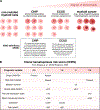Clonal haematopoiesis, ageing and kidney disease
- PMID: 37884787
- PMCID: PMC10922936
- DOI: 10.1038/s41581-023-00778-x
Clonal haematopoiesis, ageing and kidney disease
Abstract
Clonal haematopoiesis of indeterminate potential (CHIP) is a preclinical condition wherein a sizeable proportion of an individual's circulating blood cells are derived from a single mutated haematopoietic stem cell. CHIP occurs frequently with ageing - more than 10% of individuals over 65 years of age are affected - and is associated with an increased risk of disease across several organ systems and premature death. Emerging evidence suggests that CHIP has a role in kidney health, including associations with predisposition to acute kidney injury, impaired recovery from acute kidney injury and kidney function decline, both in the general population and among those with chronic kidney disease. Beyond its direct effect on the kidney, CHIP elevates the susceptibility of individuals to various conditions that can detrimentally affect the kidneys, including cardiovascular disease, obesity and insulin resistance, liver disease, gout, osteoporosis and certain autoimmune diseases. Aberrant pro-inflammatory signalling, telomere attrition and epigenetic ageing are potential causal pathophysiological pathways and mediators that underlie CHIP-related disease risk. Experimental animal models have shown that inhibition of inflammatory cytokine signalling can ameliorate many of the pathological effects of CHIP, and assessment of the efficacy and safety of this class of medications for human CHIP-associated pathology is ongoing.
© 2023. Springer Nature Limited.
Conflict of interest statement
Competing Interests
P.N. reports research grants from Allelica, Apple, Amgen, Boston Scientific, Genentech / Roche, and Novartis, personal fees from Allelica, Apple, AstraZeneca, Blackstone Life Sciences, Foresite Labs, Genentech / Roche, GV, HeartFlow, Magnet Biomedicine, and Novartis, scientific advisory board membership of Esperion Therapeutics, Preciseli, and TenSixteen Bio, scientific co-founder of TenSixteen Bio, equity in Preciseli and TenSixteen Bio, and spousal employment at Vertex Pharmaceuticals, all unrelated to the present work. M.B.L. reports received speaking and advisory board fees from Bayer, Otsuka, Reata and Sanofi. The remaining authors declare no competing interests.
Figures




References
Publication types
MeSH terms
Grants and funding
LinkOut - more resources
Full Text Sources

